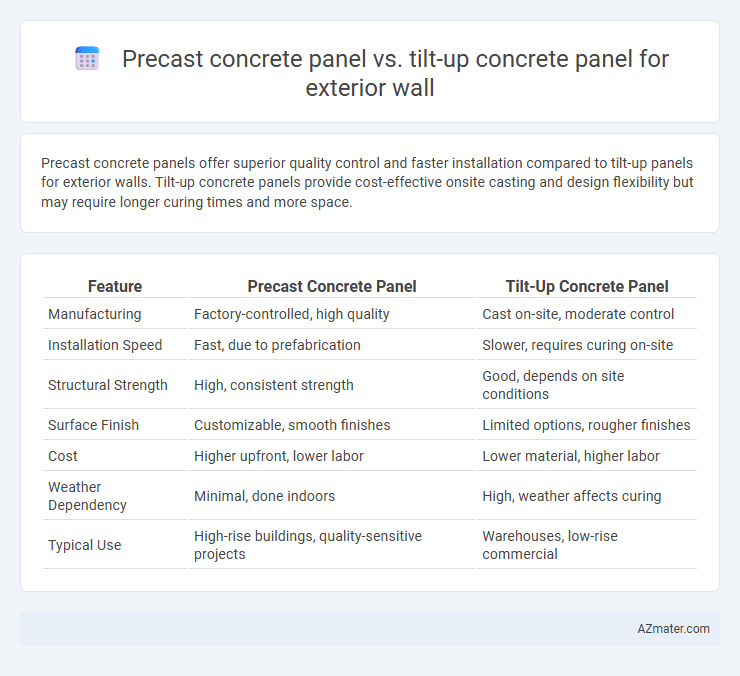Precast concrete panels offer superior quality control and faster installation compared to tilt-up panels for exterior walls. Tilt-up concrete panels provide cost-effective onsite casting and design flexibility but may require longer curing times and more space.
Table of Comparison
| Feature | Precast Concrete Panel | Tilt-Up Concrete Panel |
|---|---|---|
| Manufacturing | Factory-controlled, high quality | Cast on-site, moderate control |
| Installation Speed | Fast, due to prefabrication | Slower, requires curing on-site |
| Structural Strength | High, consistent strength | Good, depends on site conditions |
| Surface Finish | Customizable, smooth finishes | Limited options, rougher finishes |
| Cost | Higher upfront, lower labor | Lower material, higher labor |
| Weather Dependency | Minimal, done indoors | High, weather affects curing |
| Typical Use | High-rise buildings, quality-sensitive projects | Warehouses, low-rise commercial |
Introduction to Precast and Tilt-Up Concrete Panels
Precast concrete panels are factory-cast, cured, and then transported to the construction site, offering high quality control, durability, and faster installation for exterior walls. Tilt-up concrete panels are cast horizontally on-site and lifted into place, reducing transportation costs and enabling larger panel sizes but requiring ample site space for casting and lifting equipment. Both methods provide strong, energy-efficient exterior wall solutions with distinct advantages based on project scale, location, and logistics.
Overview of Exterior Wall Construction Methods
Precast concrete panels offer factory-controlled manufacturing, ensuring uniform quality and faster site installation for exterior wall construction, while tilt-up concrete panels are cast on-site, allowing for cost-effective and flexible design adjustments. Both methods provide durable and fire-resistant exterior walls, but precast panels typically deliver superior surface finishes and enhanced thermal performance due to precise casting conditions. Choosing between precast and tilt-up depends on project scale, budget, and timeline, with precast favored for repetitive designs and tilt-up preferred for lower initial costs and local material use.
Precast Concrete Panels: Definition and Process
Precast concrete panels are factory-produced concrete wall elements manufactured by casting concrete into reusable molds before transporting them to the construction site. This controlled environment allows for superior quality, precise dimensions, enhanced strength, and embedded finishes or insulation compared to on-site methods. The panels are lifted into position using cranes, ensuring faster installation and reduced construction time for exterior walls.
Tilt-Up Concrete Panels: Definition and Process
Tilt-up concrete panels are large precast concrete slabs cast horizontally on-site and then lifted into position to form exterior walls, offering rapid construction and cost efficiency. This process involves pouring concrete into forms on the building slab or a casting bed, allowing for customized panel sizes with embedded finishes or insulation, before being hoisted by cranes to create a solid building envelope. Tilt-up panels provide excellent structural integrity and thermal performance, making them a popular choice for commercial and industrial exterior walls compared to traditional precast concrete panels fabricated off-site.
Comparative Installation Techniques
Precast concrete panels are manufactured in controlled factory environments, allowing for precise quality control and rapid on-site installation by lifting and securing fully cured panels. Tilt-up concrete panels are cast directly on the job site and tilted into place using cranes after reaching sufficient curing strength, which integrates wall fabrication and erection but requires more site space and coordination. Both methods rely on cranes for placement, but precast panels offer faster installation with less on-site labor compared to the sequential casting and lifting process of tilt-up panels.
Structural Performance and Durability
Precast concrete panels offer superior structural performance with high compressive strength and enhanced resistance to seismic forces due to their controlled manufacturing process. Tilt-up concrete panels provide good durability but may have variable quality depending on onsite casting conditions, affecting consistency in performance. Both methods provide robust exterior wall solutions, yet precast panels generally deliver longer-term durability and reduced maintenance through factory precision and improved curing techniques.
Architectural Flexibility and Design Options
Precast concrete panels offer superior architectural flexibility with the ability to incorporate intricate textures, custom colors, and embedded materials, allowing for detailed and highly customized exterior wall designs. Tilt-up concrete panels provide a more cost-effective solution with faster onsite construction but typically feature simpler surface finishes and limited design variations compared to precast. The choice between precast and tilt-up panels depends heavily on project-specific aesthetic requirements and design complexity for exterior walls.
Cost Implications and Project Timelines
Precast concrete panels typically incur higher upfront material and transportation costs but enable faster installation due to factory-controlled production, reducing overall project timelines. Tilt-up concrete panels offer lower material and casting expenses as they are cast on-site, but the construction duration may extend with formwork setup and curing time. Both methods impact labor costs and scheduling differently, with precast panels optimizing rapid assembly and tilt-up panels benefiting projects with budget constraints and flexible timelines.
Environmental Impact and Sustainability
Precast concrete panels reduce environmental impact through controlled manufacturing processes that minimize waste and allow for the use of recycled materials, resulting in lower embodied carbon compared to tilt-up panels. Tilt-up concrete panels often require on-site casting, which can generate more waste, increased energy use, and greater emissions from heavy equipment operation. Sustainable benefits of precast panels include enhanced thermal performance and durability, contributing to energy efficiency and longer lifespan for exterior walls in building projects.
Choosing the Right Panel System for Your Project
Choosing the right panel system for your exterior wall depends on factors like project scale, budget, and construction timeline. Precast concrete panels offer high precision, superior finish quality, and faster installation due to factory-controlled conditions, making them ideal for complex architectural designs and tight schedules. Tilt-up panels are often more cost-effective for large-scale projects with simpler designs, providing rapid onsite construction and flexibility in panel size, but may require longer curing times and careful site coordination.

Infographic: Precast concrete panel vs Tilt-up concrete panel for Exterior wall
 azmater.com
azmater.com